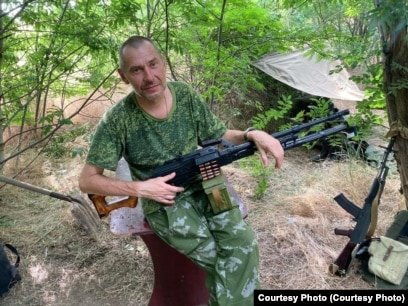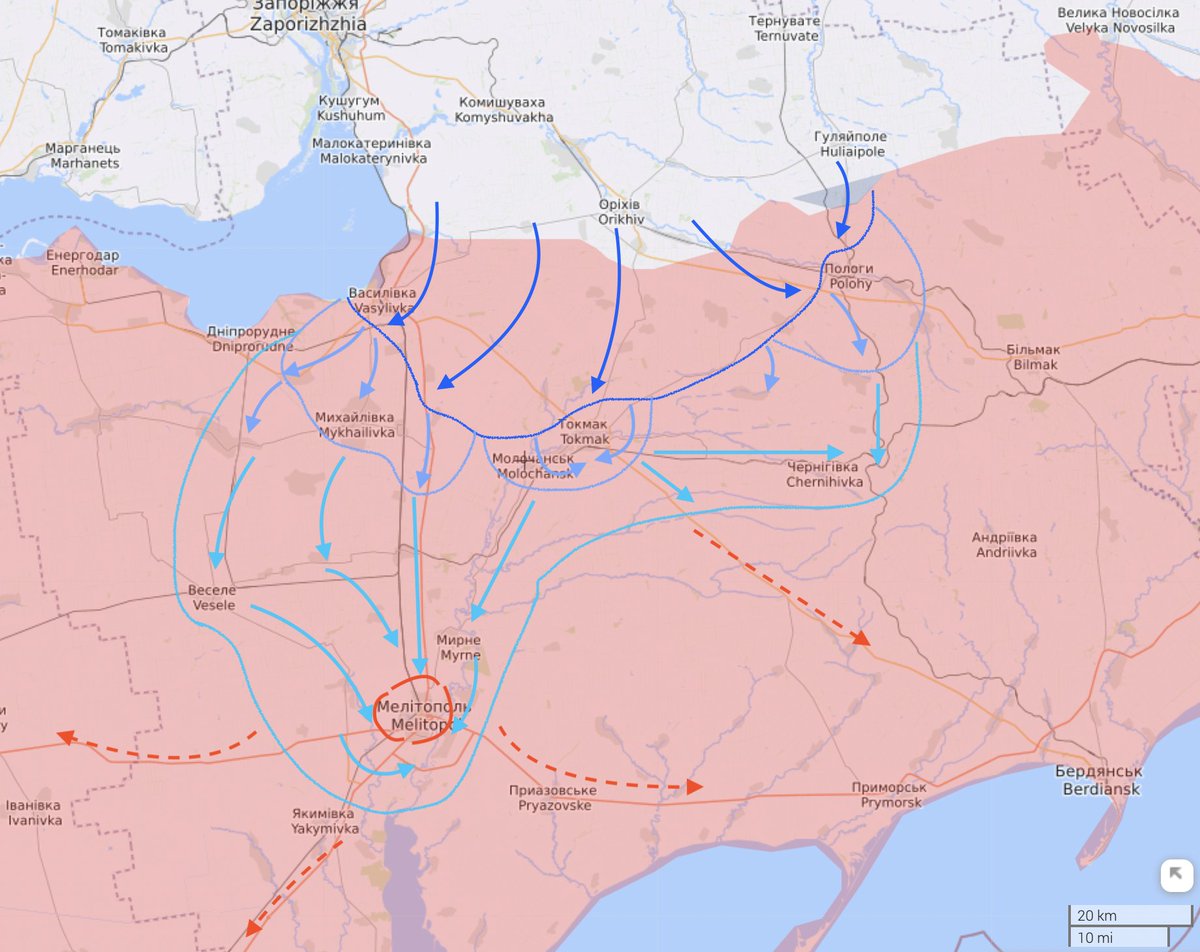1/ This thread is the third part of @IanMatveev's translated analysis of the military and geographical considerations around possible Ukrainian offensive options in the south. Part 1 is here:
https://twitter.com/ChrisO_wiki/status/1653143818814857216
3/ From @IanMatveev:
Part 6 - support from the right bank.
Artillery support is an important task for AFU units on the right bank, but there is another one.
Part 6 - support from the right bank.
Artillery support is an important task for AFU units on the right bank, but there is another one.
4/ They must restrain the Russian units covering the Dnipro, or better yet, force Russia's generals to send reinforcements, depriving the main offensive area of necessary forces.
5/ How to do this? You may have read the story of the failed AFU landing in Energodar in the fall of 2022 (thetimes.co.uk/article/ukrain…).
6/ If this information is to be believed, the operation, which involved up to 600 soldiers, was cancelled at the very beginning because the Russian army used artillery en masse. This is their weakness. 

7/ There must be a similar situation in the Nova Kakhovka area, as well as in the Dnipro floodplain opposite Kherson. The Russian army spends a lot of effort to cover these areas and keeps artillery there. Which will be completely useless ife the AFU breaks through to Melitopol.
8/ The main task for the Ukrainian units on the right bank of the Dnipro River is to actively pretend to land paratroopers. This would force the Russian generals to maintain the defence line along the river until the very last moment.
9/ As I said, the critical points here are the Kinburn Spit, Hola Prystan-Oleshky, Nova Kakhovka and Energodar. But in general, false landings by small groups on high-speed boats can be conducted throughout the Dnipro. It is certainly risky, but promises great reward.
10/ It seems that the AFU is already successfully playing this game – all sorts of Russian pro-war Telegram channels are murmuring about this. 

11/ Analysts (uacontrolmap.com) say the Dnipro's left bank is defended by two artillery brigades, several Special Forces divisions, marine brigades (61st, 810th and 126th), motorised riflemen (80th, 34th, 205th), the 83rd Airborne Brigade, 214th Tank Regiment and others. 

12/ Energodar is under the control of Kadyrov's men. Perhaps not all of them are here now, but a significant part of them probably remains. They could cause a lot of trouble if they hit the advancing Ukrainian troops from the west. So it is necessary to divert them properly.
13/ In addition to movement along the river, it is necessary to bombard Russian positions on the left bank. Perhaps with the involvement of aviation, helicopters with unguided rockets and even HIMARS. At the same time the AFU will have to decide the site of the actual landing.
14/ Preferably in Nova Kakhovka – the crossing is easier to restore and guard there, and the position of the city is close to the advancing units from Zaporizhzhia. 

15/ Sooner or later Putin's units will withdraw from the bank of the Dnipro, and here it is impossible to delay - it will be necessary to move immediately and create a bridgehead.
16/ Part 7 - difficult moments
In this part I will highlight and break down all the problems and challenges that the AFU will have to solve in order for the offensive to be successful or to succeed at all. We must not forget that this entire operation is incredibly complex.
In this part I will highlight and break down all the problems and challenges that the AFU will have to solve in order for the offensive to be successful or to succeed at all. We must not forget that this entire operation is incredibly complex.
17/ Open terrain
Advancing directly across the fields is very risky. In order not to lose a lot of equipment and soldiers to artillery strikes the AFU will have to move quickly, perhaps not even counting losses at this point, throwing in damaged tanks and armoured vehicles.
Advancing directly across the fields is very risky. In order not to lose a lot of equipment and soldiers to artillery strikes the AFU will have to move quickly, perhaps not even counting losses at this point, throwing in damaged tanks and armoured vehicles.
18/ Open terrain welcomes long-range tank duels and ATGM warfare. But here the technological advantage lies with the AFU, so all that remains is to find buried and camouflaged firing points and the tanks of Putin's army.
19/ Minefields
While trenches with concrete pyramids look frankly cheesy, minefields, for all their simplicity and artisanship, will be a real obstacle. Even old Soviet TM-62M mines are capable of stopping modern tanks, making them easy prey for artillery.
While trenches with concrete pyramids look frankly cheesy, minefields, for all their simplicity and artisanship, will be a real obstacle. Even old Soviet TM-62M mines are capable of stopping modern tanks, making them easy prey for artillery.
20/ Remember Vuhledar, where it was mines that initially stopped the convoy. This is how the Russian army automatically lays mines using the GMZ-3 system. It ploughs the field and automatically shoves mines in the ground.
21/ The minefield has another sneaky trait – you can't see it. It's an invisible enemy that you have to reckon with and check everything and everywhere. It takes effort and time. The very thing the AFU has very little of.
22/ Several types of anti-mine systems will help to solve the problem of minefields. From Leopard 2R and Wisent 1 tanks to Bozena 5 drones from Slovakia.
23/ And also an analogue of the Russian UR-77 Meteorit – the American M58 Mine Clearing Line Charge. True, so far very little of this stuff has been announced. If a couple of dozen have been supplied, it will be enough, it's good.
24/ Two large cities
Tokmak and Melitopol - how to liberate them? It is possible that the Russian troops themselves will quickly flee the cities, but one cannot count on that. Especially as far as Melitopol is concerned.
Tokmak and Melitopol - how to liberate them? It is possible that the Russian troops themselves will quickly flee the cities, but one cannot count on that. Especially as far as Melitopol is concerned.
25/ Let's say, Tokmak can even be blockaded and bypassed, and then gradually stormed or Russian units forced to surrender. But the Russians, on the other hand, will clearly try to hold Melitopol.
26/ This big city has a huge residential area, several neighbourhoods of new buildings, the Molochna River and canal, an industrial zone and an airfield. All around are solid fields - the AFU will have to attack in the open. 

27/ The first step to liberate the city will be to reach the line from the airfield to Udachne – Novenska – Danylo-Ivanivka – Timofivka.
28/ If the breakthrough on the eastern bank of the Molchnaya River goes well, you can try to take Voznesenka and Kostyantynivka to completely surround Melitopol.
29/ Lack of air support
For such large-scale offensives, air support is as vital as breathing. But the Ukrainian Air Force clearly does not have enough planes, and the Russian air defence and air force also provide countermeasures.
For such large-scale offensives, air support is as vital as breathing. But the Ukrainian Air Force clearly does not have enough planes, and the Russian air defence and air force also provide countermeasures.
30/ It is clear that there will be local support in the form of AGM-88 HARM missiles against radars, there will also be JDAM guided bombs, as well as of course Mi-8 and Su-25s with unguided missiles. But all this is not enough. 

31/ HIMARS strikes (which are well within range) and the active use of barrel artillery will have to compensate for aerial bombing. By the way, the lightness and mobility of the M777s will play well here - the guns clearly have to move quickly near the front.
32/ Complicated Logistics
Logistics is central to the offensive. Because resources run out quickly, you need to promptly bring in new shells, fuel, food for soldiers, spare parts, and all the other little things up to camouflage nets and tires for armoured vehicles.
Logistics is central to the offensive. Because resources run out quickly, you need to promptly bring in new shells, fuel, food for soldiers, spare parts, and all the other little things up to camouflage nets and tires for armoured vehicles.
33/ It's not a given that you can get the main highways under control quickly, which means you'll have to build logistics along country roads and even fields. A small plus is the city of Zaporizhzhia nearby, of course all the cargo will flow out of it.
34/ However, this can become a vulnerability, as Russian aviation and artillery will attack the only route. Therefore, it is important to occupy and use the crossing at Nova Kakhovka as soon as possible. 

35/ More trucks are vital, and here I am pleased with the recent news of truck deliveries (from Germany, Belgium and the U.S.). When we look at Bakhmut's supply routes, we see a bunch of civilian cars there. They don't carry much cargo, but they congest the roads. We need trucks.
36/ Stockpiling
This problem must be solved right now, because during the attack the consumption and losses of shells and fuel will be record high. Indirect evidence suggests that there are still problems with the supply of shells.
This problem must be solved right now, because during the attack the consumption and losses of shells and fuel will be record high. Indirect evidence suggests that there are still problems with the supply of shells.

37/ Ukraine's own production is not capable of covering all requirements for shells. It is quite possible that it is the shortage of ammunition that is delaying the counterattack.
38/ It will also force the AFU to act faster, to have time to win until they run out of shells. The main deficit, of course, is the supply of 155mm ammunition. Let's see how Ukraine solves this problem.
39/ Part 8 – the main stages
First stage – breakthrough and offensive to the line Vasylivka – Tokmak – Polohy. Deadline – a week.
First stage – breakthrough and offensive to the line Vasylivka – Tokmak – Polohy. Deadline – a week.

40/ An extremely important stage, which should be done as quickly as possible. I think that if the AFU gets bogged down in breakout battles for more than a week, the offensive may be disrupted. After that, the first Russian reserves will begin to approach the defence lines.
41/ The greatest depth of penetration at this stage is 25 kilometres; if the offensive is successful, it is possible to reach Tokmak in one day. But it will take time to liberate various settlements and small fortifications on the flanks
42/ At this stage it will already be clear what directions the attacks are going in, what forces the AFU has sent, and how easily the Russian defence lines can be broken through. I do not think that already at this point Putin's troops will start to retreat.
43/ The second stage is the fight for the initiative. Slow advance of the AFU, search for weaknesses, brutal battles with heavy losses to deplete Russian forces. The timeframe is one month. 

44/ The key stage of the entire offensive, during which it will be decided whether a merely successful attack will turn into a large-scale counterattack with the liberation of large areas of territory.
45/ The first week will answer the question of whether the Russian army is ready for resistance or will retreat immediately to Mariupol and Crimea.
46/ The Russians could have two options for counterattack.
1. Trying to fight the AFU on the lines that they will break through in the beginning.
2. Strengthening the trench lines near Melitopol and the land corridor. They did not dig a trench 70 kilometres long for nothing.
1. Trying to fight the AFU on the lines that they will break through in the beginning.
2. Strengthening the trench lines near Melitopol and the land corridor. They did not dig a trench 70 kilometres long for nothing.
47/ In both cases, the Ukrainian troops will engage in a full-fledged battle with Russian units, and here the effect of surprise will fade into the background.
48/ But the quality of training and equipment will play on the side of the AFU - if the new units are equipped with all the promised Bradleys, Strykers, Leopards, and other useful vehicles, if they are allocated enough artillery and ammunition. 

49/ That is why it is important to finish the first phase quickly, so that the enemy will be forced to fight without putting their forces in order.
50/ The third stage is a breakthrough to the sea, an advance Melitopol and the Sea of Azov, and the defeat of the remaining Russian units. Length – 2-3 weeks. 

51/ When the AFU wins and retains the initiative, the second, main phase of the breakthrough will begin. For this they will take a short pause of 3-7 days to accumulate forces.
52/ During this time the fate of Tokmak may be decided, if the Russian troops decide to retreat or are completely surrounded in the city.
53/ It is possible that during the second phase there will be new breakthroughs of the original Zaporizhzhia front, and the goals and direction of the main strike will change. But the essence will remain the same – movement to the sea.
54/ In my opinion, Melitopol and Crimea will remain the main target. At this point it will be necessary to expand and strengthen the flanks against a counterattack from the east. And also to strike the retreating troops to deprive them of equipment and ammunition.
55/ The fourth stage is the liberation of territory, pushing Russian forces off the left bank of the Dniepro. It is possible to break through to Crimea or to the peninsula itself. The time frame is from a couple of weeks to several months. 

56/ This is no longer a battle, but rather a mop-up. It will go on for a long time, just like the liberation of the right bank of the Dnipro after the retreat of Russian troops, as well as the eastern part of the Kharkov region.
57/ The Russian troops will try to delay the AFU to the Isthmus to the Crimea by organising defences on the mainland, but most of them will already be on the peninsula.
58/ Unless, of course, the generals are so crazy as to leave troops surrounded between the Dnepro and the new front from Vasylivka to Melitopol.
In this case, the AFU will need to recognise this situation in time and take all measures to block the path to Crimea.
In this case, the AFU will need to recognise this situation in time and take all measures to block the path to Crimea.
59/ Then Russia risks losing a huge force - a couple of tens of thousands of people will end up in the cauldron.
60/ Conclusion
The above is nothing more than an imagining of how a Ukrainian offensive might go. This should not be taken as a forecast, but rather as a light analysis and an attempt to speculate on the topic using open data on the war.
The above is nothing more than an imagining of how a Ukrainian offensive might go. This should not be taken as a forecast, but rather as a light analysis and an attempt to speculate on the topic using open data on the war.
61/ Perhaps this topic will be of interest to you and you have your own thoughts, additions, corrections or questions. Email them to me at arrowsandmap@gmail.com. I will certainly read it all. Also, subscribe to my Telegram feed: t.me/arrowsmap.
62/ Reflections like this can be useful for understanding the future offensive of the AFU, because they contain an analysis of basic things. In any other area, all of these inputs will remain, just the locations, details, and timings will change. Thanks for your time!
(Original thread is linked below)
https://twitter.com/ian_matveev/status/1649339926511493120
Also please note that I inadvertantly tagged the wrong Twitter handle – it's @ian_matveev, of course.
• • •
Missing some Tweet in this thread? You can try to
force a refresh

 Read on Twitter
Read on Twitter








